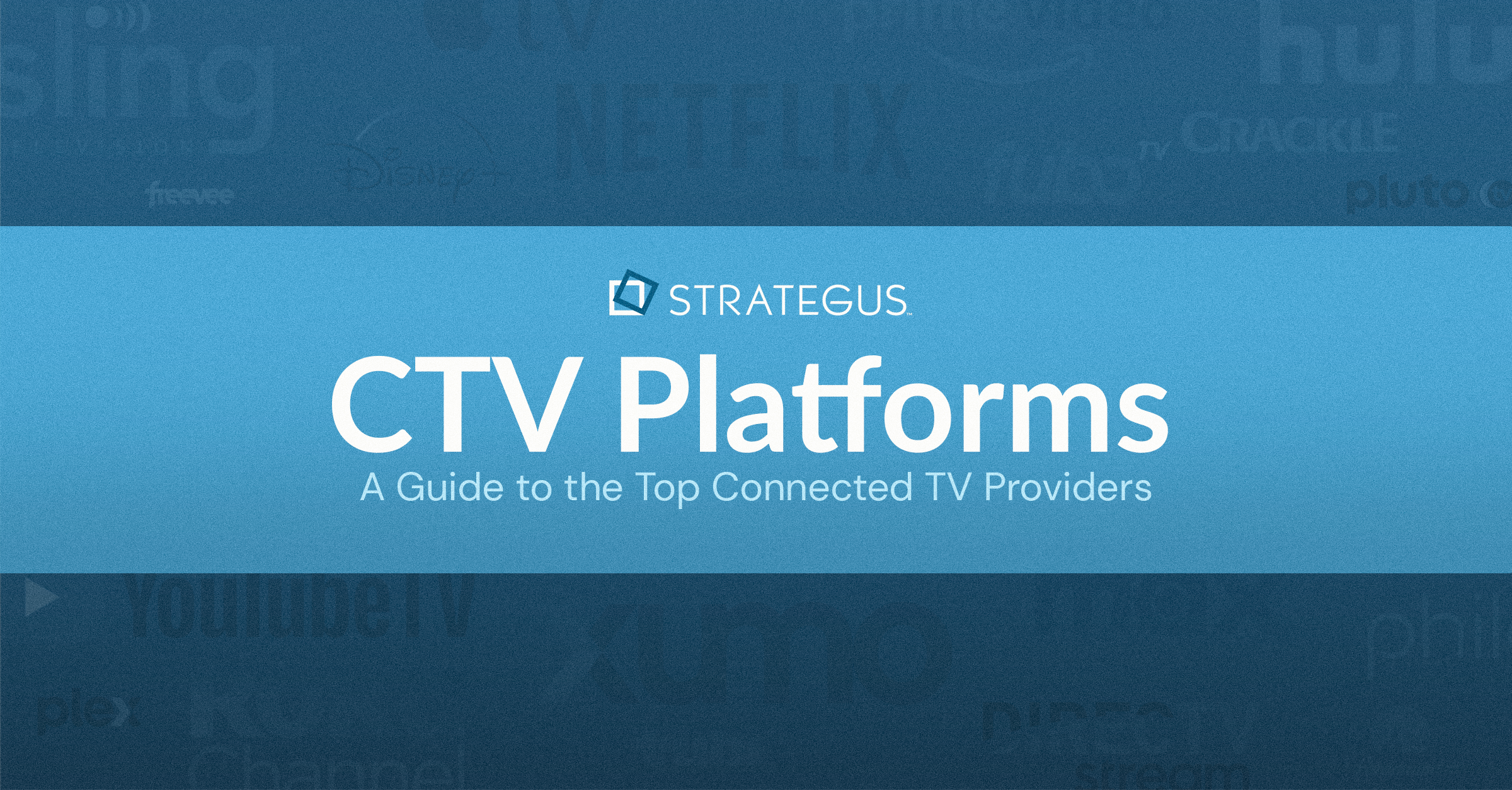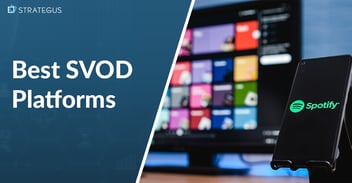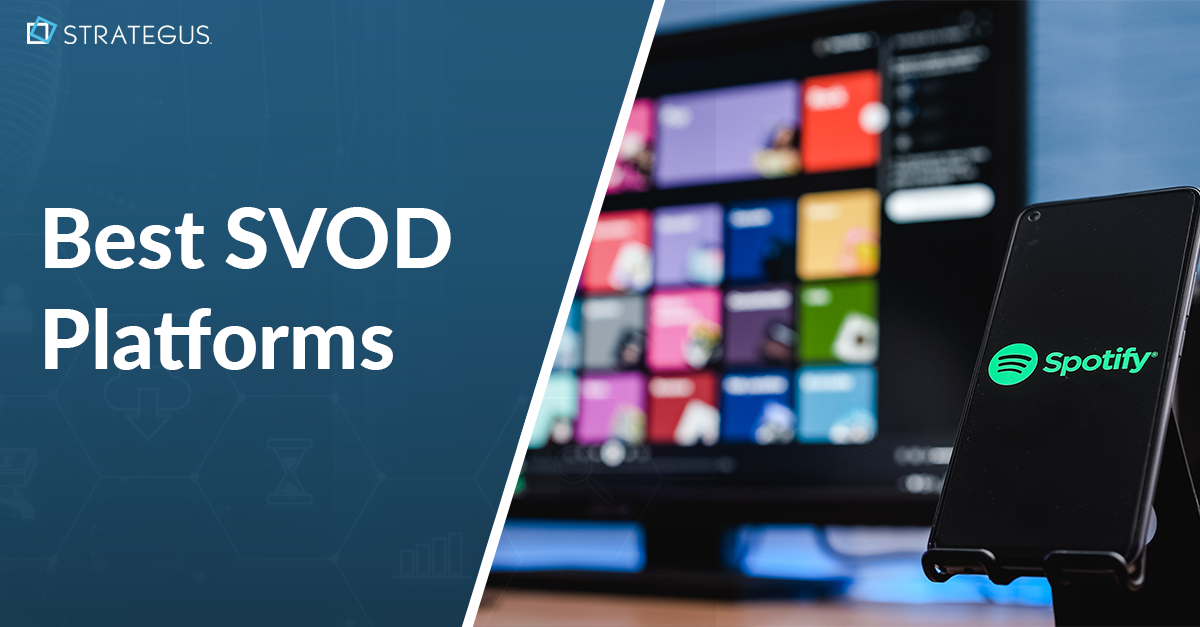- Home
- Strategus Blog
- CTV Platforms: A Guide to the Top Connected TV Providers
CTV Platforms: A Guide to the Top Connected TV Providers
 Traci Ruether
Traci Ruether
16 minutes read

The term connected TV (CTV) platform means different things to different people.
Depending on who you’re talking to, they may be referring to:- The internet-connected TV devices that we use to watch streaming content, including smart TVs like Samsung, streaming devices like Roku, and gaming consoles like Xbox.
- The streaming services and apps that distribute this content, such as VOD services like Netflix, FAST apps like Tubi, and vMVPDs like YouTube TV.
- The demand-side platforms (DSP), data management platforms (DMPs), and supply-side platforms (SSPs) that advertisers use to automate CTV ad placement, which spans major brands across the CTV ecosystem like The Trade Desk, Nielsen, and Amazon.
It’s all rather convoluted. And this complexity leads to confusion about how CTV ads should be purchased and which vendors advertisers should work with.
In this guide to CTV platforms, we detail each step of the programmatic supply chain, important players across the ecosystem, and how advertisers can streamline things by taking a vendor-agnostic approach to CTV advertising.
The Role of Programmatic Ad Placement in CTV
Before getting into individual platforms, let’s unpack why the CTV ecosystem is so disjointed.
In the early days of TV, securing ad space involved direct negotiations between advertisers and publishers. Advertisers would go directly to the TV networks that they thought their audience was tuning into and strike a deal. This required a lot of assumptions about who was watching what, as well as major upfront investments to deliver generic commercials to broad audiences.
With the advent of streaming TV, things became digital and automated. Today, 75% of all CTV ads are placed programmatically, using real-time bidding to automatically transact across inventory providers.
This method takes a content-agnostic approach by targeting ads based on the individual viewers’ characteristics and behaviors, rather than tying media purchases to the content itself.
The benefits of programmatic CTV for advertisers are threefold:
- Targeted and efficient: Programmatic CTV makes it easy to reach the right audience while optimizing ad spend.
- Content-agnostic: Ads are placed based on viewer data, which gives advertisers the flexibility to execute campaigns across multiple platforms.
- Measurable and optimizable: Advertisers gain access to data about ad performance, allowing for real-time insight and future optimization.
A Look at the Programmatic Supply Chain
So what does this have to do with the fragmentation across the CTV landscape? Quite a lot, as it turns out.

You see, there are several steps between the advertiser and the publisher when transacting programmatically, which is why so many different ‘CTV platforms enter the picture. Let’s take a closer look.
Supply-Side Platforms (SSPs)

SSPs serve publishers and content owners. They act as middlemen that aid with the selling of ad inventory. More specifically, SSPs send bid requests to multiple ad exchanges when ad space becomes available, providing detailed information about the audience that will be exposed to the ad, such as demographics, interests, and viewing habits.
This empowers advertisers to target their campaigns with greater precision and publishers to maximize their revenue by attracting the most relevant bids for their ad space.
Popular CTV SSPs include:
- Magnite
- Freewheel
- Pubmatic
- Index Exchange
- Microsoft Invest
- Beachfront
Ad Exchanges

Next, we have ad exchanges. These connect SSPs and DSPs, facilitating the real-time auction of ad impressions. The instantaneous nature of these auctions allows for efficient and competitive ad buying, ensuring that the highest bidder secures the ad space.
Ad exchanges come in two different flavors: open ad exchanges and private marketplaces (PMPs). The difference between the two comes down to inventory quality and access. While open ad exchanges can be accessed by any advertisers looking to buy inventory, PMPs are more exclusive, controlling which media buyers can participate.
These restricted environments provide access to premium inventory, which helps prevent ad fraud and ensure brand safety. But to gain access to PMP deals, advertisers must establish relationships with publishers or work with a CTV managed service provider like Strategus with a robust network of inventory partners.
Popular CTV ad exchanges include:
- Magnite
- OpenX
- Microsoft Invest
Demand-Side Platforms (DSPs)

As we move further away from the publisher side of things, we get to DSPs, which represent advertisers. These platforms integrate with multiple ad exchanges, allowing advertisers to access a vast pool of ad inventory from various publishers in a single platform.
When a bid request comes in from an SSP, the DSP uses algorithms to decide which ad impressions to bid on and at what price by factoring in considerations like the advertiser's budget, the value of the specific audience segment, and real-time competitor bids.
Popular CTV DSPs include:
- The Trade Desk
- Amazon DSP
- Microsoft Invest
Data Management Platforms (DMPs)

Next comes data management platforms. DMPs help collect and analyze the data that programmatic advertising hinges on. This includes information about personal interests, browsing activity, lifestyle choices, and more.
Advertisers then use this data to make informed decisions and target specific audience segments effectively. The result? Relevant and engaging ads are served to users who are receptive to the message.
Popular CTV DMPs include:
- Amazon
- Experian
- Foursquare
- Kroger
- Mastercard
- Microsoft
- Resonate
- Skydeo
- Datonics
Measurement and Verification Vendors

Finally, let’s not forget about measurement and verification vendors. One of the key differentiators between CTV and linear TV advertising is the ability to understand the reach and impact of campaigns through digital measurement. With the right vendors, media buyers can gain dynamic insight into every aspect of campaign performance and get a better understanding of how viewers progress through the buyer’s journey.
Additionally, verification provideirs analyze ad traffic and block fraudulent activity like ad injection, bot traffic, and invalid impressions. Streamlining Integrations Across the CTV Ecosystem
This helps ensure that ad investment goes toward human viewers and not falsified metrics.
Popular CTV measurement and verification providers include:
- Nielsen
- Lucid
- SambaTV
- DoubleVerify
- Adsquare
- Foursquare
- Integral Ad Service (IAS)
- iSpot
- Experian
Streamlining Integrations Across the CTV Ecosystem
Getting the full benefit of CTV requires integrations across the ecosystem, which often means building out a roster of vendor partnerships and committing a substantial budget to monthly minimums.
It doesn't have to be this way though.
At Strategus, we provide direct integration with all of the DMPs, ad exchanges, SSPs, DMPs, and measurement and verification providers detailed above — minimizing the complexity of it all. With a single provider for all their CTV needs, our customers can access multiple supply sources and data providers without the headache.
Top Viewer CTV Platforms in 2024
Now that we’ve covered the CTV platforms operating behind the scenes, let’s look at the viewer side of things. For consumers, CTV platforms describe the devices and streaming services used to access streaming content. These are important to advertisers too, as they play a major role in CTV ad placement.
CTV Devices
Any equipment used to stream video content on television sets can be classified as a CTV device. Smart TVs, streaming media players, gaming consoles, and set-top boxes are all examples of this.
Because laptops and mobile devices are used for small-screen streaming, they fall in the category of OTT devices and offer less premium inventory than what’s found on the big-screen television. For that reason, when we talk about CTV devices, we’re only referring to the equipment that support big-screen viewing.
%20devices-1.png?width=893&height=404&name=connected%20tv%20(CTV)%20devices-1.png)
Today, almost 90% of homes have an internet-connected TV. And the devices themselves play a bigger role in CTV advertising than you might assume.
AdExchanger’s Anthony Vargas explains:
“Many smart TVs or streaming devices that plug into a TV come equipped with a default free ad-supported television (FAST) channel, such as Samsung TV Plus, LG Channels, or the Roku Channel. These channels typically function as large ad networks.”
As such, these internet-connected gadgets are more than just screens — they provide the inventory, data, and platform integration that fuels the entire ecosystem.
CTV devices serve 3 functions:
- Inventory. CTV devices are the access points for viewers to reach a library of CTV content. Programmatic ad placement relies on this inventory to function.
- Targeting and Measurement: CTV devices provide valuable data for ad targeting and measurement. Smart TVs and streaming devices collect information about viewer demographics, viewing habits, and app usage, which DMPs then store and share with DSPs for ad targeting.
- Integration With Publishers: Many CTV devices integrate with programmatic infrastructure. For instance, your smart TV may offer built-in app stores where viewers can download apps that are already directly connected to ad exchanges. In some cases, CTV devices give more prominence to different publishers by guiding content discovery, which can even influence viewing patterns.
Here’s a list of the top CTV devices across each subcategory.
Smart TVs

Any equipment used to stream video content on television sets can be classified as a CTV device. Smart TVs, streaming media players, gaming consoles, and set-top boxes are all examples of this.
Smart TVs integrate internet connectivity and a built-in operating system, allowing users to stream content directly from the internet, browse the web, and access various applications without an external device like a streaming stick. These are equipped with user-friendly interfaces that give viewers instant access to a wide range of preloaded streaming services.
Popular smart TVs in 2024 include:
- Samsung QN90A Neo QLED
- LG OLED C1 Series
- Sony A90J OLED
- Vizio P-Series Quantum
- TCL 6-Series with Google TV
- Hisense U8G ULED
- Philips OLED 706
- Panasonic JZ2000 OLED
- Sharp 4K UHD Smart TV
- Toshiba Fire TV 2024 Edition
Streaming Media Players

Streaming media players like Roku transform ‘dumb’ TVs into internet-connected devices that can access streaming content. These devices connect standard televisions to home internet networks, providing access to streaming content without the expense of replacing the entire TV set. Streaming media players are typically compact, easy to install, and come with intuitive interfaces.
Popular streaming media players in 2024 include:
- Roku Ultra
- Amazon Fire TV Stick 4K Max
- Apple TV 4K (3rd Generation)
- Google Chromecast with Google TV
- NVIDIA Shield TV Pro
- Amazon Fire TV Cube
- Roku Streaming Stick+
- TiVo Stream 4K
- Xiaomi Mi Box S
- Zidoo Z9X
Gaming Consoles

Gaming consoles are specialized devices designed for playing video games. These are often equipped with advanced graphics, high-speed processors, and extensive libraries of games. And because the top gaming consoles today offer access to streaming services, social media, and more, they also serve as multimedia hubs.
Popular gaming consoles in 2024 include:
- PlayStation 5
- Xbox Series X
- Nintendo Switch OLED Model
- Xbox Series S
- Steam Deck
- PlayStation 5 Digital Edition
- Nintendo Switch Lite
- Atari VCS
- Intellivision Amico
- Evercade VS
Set-Top Boxes

Set-top boxes are devices that receive and decode video signals from cable and satellite services, enabling viewers to consume a wide range of television programming on a conventional TV. These boxes are offered by cable and satellite service providers and often include features like on-demand streaming, digital video recording (DVR), and high-definition channels.
Popular set-top boxes in 2024 include:
- TiVo Edge
- Xfinity X1
- Dish Network Hopper 3
- Spectrum 210
- AT&T TV
Ad-Supported Streaming Services
Now, let’s shift from the CTV devices where content is displayed to the over-the-top (OTT) services that distribute these streams.
Today, the OTT model has grown into a versatile ecosystem that caters to every viewing preference and price point. Many services like YouTube TV and Tubi blur the lines between traditional TV and streaming, offering linear channels alongside on-demand libraries. Advertising has also become a key part of monetizing these services, with every major streaming platform now offering an ad-supported tier.
Ad-supported OTT spans a few categories, with top players in each bucket.
Hybrid Video on Demand (HVOD)

Ad-supported subscriptions to services like Netflix, Prime, and Disney+ fall into the HVOD category because they generate revenue through a mix of commercials and subscription plans. This appeals to viewers who want premium content but can’t justify the high-end price tag.
Popular HVOD services in 2024 include:
- Amazon Prime
- Netflix
- Disney+
- Apple TV+
- Max
Learn more about HVOD services →
Virtual Multichannel Video Programming Distributors (VMVPD)

vMVPD services like YouTube TV deliver linear TV channels (with ads) to paying subscribers. Households looking to cut the cord without losing access to premium live sports content and must-watch shows from popular cable networks are the target market for these services.
Popular vMVPD services in 2024 include:
- YouTube TV
- Hulu Live
- Sling TV
- FuboTV
- Philo
- DirectTV Stream
Free Ad-Supported Streaming TV (FAST)

For viewers looking to do away with paid subscriptions altogether, FAST apps make it easy. These streaming services deliver linear channels at no cost to viewers — playing everything from reruns, old movies, platform-specific content, and local news. Many smart TVs (like Roku) have default FAST apps (like the Roku Channel) within the interface, giving viewers a free and easy option for lean-back viewing out of the box.
Popular FAST services in 2024 include:
- Pluto TV
- Tubi
- The Roku Channel
- Xumo Play
- Amazon Freevee
- Crackle
- Vudu
- Plex
Advertising Video on Demand (AVOD)
A fourth streaming model worth mentioning is AVOD. AVOD is a giant category spanning everything from social media sites like YouTube and TikTok to streaming services like The Roku Channel.
Basically, any app that lets you play videos on demand in exchange for watching advertisements falls within the AVOD umbrella.
Because this model has overlap across the categories above and also includes non-premium content like social media sites, we won’t be covering the top AVOD services in this article.
A Note on Walled Gardens in CTV Advertising
While programmatic CTV offers countless advantages, the rise of walled gardens within the ecosystem is something advertisers should be aware of.
A walled garden is a closed ecosystem controlled by a single company. These companies set rules about how the data and applications are accessed, how and when advertising is displayed, and the like.
In the context of CTV advertising, walled gardens restrict advertisers in a few ways:
- Limited Reach: Because walled gardens function as closed ecosystems, they limit the ability to reach viewers across different platforms and channels. This can be a major drawback, especially for advertisers targeting niche audiences.
- Lack of Transparency: Walled gardens are often opaque, making it difficult for advertisers to understand where their ads are being placed and how they are performing. This lack of transparency makes it challenging to optimize campaigns and measure true return on ad spend (ROAS).
- Lack of Flexibility: Advertising within a walled garden creates a dependency on that specific platform. If a platform changes its policies or experiences a decline in users, it can significantly impact the success of your ad campaigns.
In addition to the concerns detailed above, purchasing CTV ads from individual publishers puts the focus on the content where ads run rather than the viewers themselves. And when advertisers do this, they make assumptions about who’s watching what rather than letting the data speak for itself.
At Strategus, we’re committed to maximizing the content-agnostic power of programmatic CTV. Our vast library of premium inventory spans 200+ publishers that dominate the media landscape and more than 843 individual deal IDs. This allows us to run cross-platform campaigns without being beholden to a single inventory source.
How to Simplify CTV Media Buying With Strategus
If there’s one takeaway from this guide, it’s that the CTV ecosystem is vast and disjointed. But it doesn’t have to be.
By partnering with Strategus, agencies and brands can take advantage of this growing channel without having to choose between different CTV publishers, SSPs, and DMPs.
Our vendor-agnostic approach integrates data and inventory from a large network of partners to reach your ideal viewers with high-impact ads that they’ll remember. From there, we make it easy to quantify ROI at every touchpoint and optimize campaigns in real time.
So rather than trying to determine which CTV platforms are best for your business, make things simple and gain instant access to publishers, DSPs, and data providers across the industry. Contact us to get started today.

Traci Ruether is a content marketing consultant specializing in video tech. With over a decade of experience leading content strategy, she takes a metrics-driven approach to storytelling that drives traffic to her clients' websites. Follow her on LinkedIn or learn more at traciruether.com.
Strategus is a managed services connected TV(CTV) advertising agency with over 60,000+ campaigns delivered. Find out how our experts can extend your team and drive the result that matter most.
Talk to an Expert
Table of Contents
Seeking a Custom CTV Strategy That Delivers?
What to read next

Best SVOD Platforms for Advertisers
The streaming wars have a new battlefront, and this time, it's all about your ad budget. Just a few years ago, SVOD meant "no commercials." Now, it...
12 minutes read

Third-Party Data Targeting for CTV: Benefits & Tactics
Third-party data. It’s a term that’s thrown around, and yet few take the time to detail its pros and cons — much less strategies for using...
7 minutes read

First-Party Data Targeting: Benefits and Tactics for CTV Advertising
First-party data is the information that companies collect directly from their customers rather than through intermediaries. Advertisers use this...
10 minutes read

Foot-Traffic Attribution: Tying Ad Impressions to In-Store Visits
The marketing funnel has changed. Today’s shoppers often begin researching products from the comfort of their homes and don’t set foot into a store...
8 minutes read
















